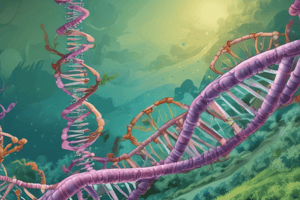Podcast
Questions and Answers
What is one of the applications of molecular tools in this course?
What is one of the applications of molecular tools in this course?
- Conducting interviews
- Learning programming languages
- Studying human diseases in model organisms (correct)
- Writing scientific papers
DNA is composed of two long strands running in opposite directions known as __________.
DNA is composed of two long strands running in opposite directions known as __________.
antiparallel
How many protein-coding genes are estimated to be in humans?
How many protein-coding genes are estimated to be in humans?
25,000 genes
What is the process called by which DNA is copied into RNA?
What is the process called by which DNA is copied into RNA?
What are the fundamental steps of Polymerase Chain Reaction (PCR)?
What are the fundamental steps of Polymerase Chain Reaction (PCR)?
Restriction enzymes are normally found in plants.
Restriction enzymes are normally found in plants.
What is the name of the enzyme that ligates DNA fragments together?
What is the name of the enzyme that ligates DNA fragments together?
DNA Cleavage is done at a specific nucleotide sequence known as the __________.
DNA Cleavage is done at a specific nucleotide sequence known as the __________.
What is a common screening strategy used in genetic engineering?
What is a common screening strategy used in genetic engineering?
Flashcards are hidden until you start studying
Study Notes
Course Overview
- Course Code: APBI305
- Title: Genetic Engineering II
- Credits: 2 CH lecture, 4 CH lab
- Prerequisites: APBI303 (Genetic Engineering I)
- Semester: Spring - Third level
Course Aim and Competencies
- Aim to impart knowledge and practical skills in advanced genetic engineering tools and applications in biotechnology.
- Develop competencies including producing and identifying GMOs, recognizing recombinant DNA roles, and applying molecular tools in biomedical research.
Course Content
- Basic concepts of genetic engineering
- Transgenic animals (Parts I & II)
- Genome editing (Parts I-IV)
- Human gene therapy
- Transgenic plants (Parts I & II)
Learning Outcomes
- Cognitive: Recognition of gene editing concepts, explanation of molecular tools, and methods for transgene delivery.
- Psychomotor: Conduct cloning experiments, genotype transgenic animals, and design genome manipulation procedures.
- Affective: Understanding benefits and limitations of genome editing.
Examination and Grading
- Attendance >25% required.
- Grading breakdown:
- Final theoretical exam (40%)
- Final practical exam (20%)
- Oral project exam (10%)
- Midterm exam (10%)
- Coursework (20%)
- Total: 100%
DNA Structure and Function
- DNA is a double-stranded molecule essential for development and functioning.
- Composed of nucleotides: purines (Adenine, Guanine) and pyrimidines (Cytosine, Thymine).
- DNA replication involves unwinding, primer addition, and nucleotide synthesis by DNA polymerase III.
Gene Expression
- Information in genes is utilized through transcription and translation processes.
- Transcription: Involves initiation, elongation, and termination to produce mRNA from DNA.
- Translation: Ribosomes synthesize proteins from mRNA codons.
RNA Types
- Coding mRNA: Encodes proteins; undergoes translation.
- Non-coding RNAs: Regulatory roles; include rRNA and tRNA.
Cloning Techniques
- DNA Cloning: Selects and amplifies specific DNA sequences.
- Polymerase Chain Reaction (PCR): Amplifies DNA through cycles of denaturation, annealing, and extension.
Recombinant DNA Technology
- Combines DNA segments using techniques such as restriction enzymes and ligation.
- Plasmids: Used as vectors for gene cloning and expression.
- Vectors: Must contain origin of replication, selectable markers, and multiple cloning sites.
Selection and Screening
- Antibiotic resistance genes are used as selection markers.
- Blue-white screening: Differentiates between recombinant vectors and parental vectors using β-galactosidase activity.
Applications of Cloning
- Genome sequencing, recombinant protein production, generation of probes, gene therapy, and creation of transgenic organisms.
Practical Applications
- Experiment design includes researching gene sequences, cloning, expressing genes in vectors, and screening for successful recombinants.
Key Techniques
- Sticky and Blunt End Ligation: Different methods for inserting DNA into vectors.
- TA Cloning: Uses PCR-generated adenine to ligate with vectors carrying a thymidine.
Summary of Important Concepts
- Explore the CRISPR/Cas9 system for genome editing.
- Understand the role of recombinant DNA in biotechnology.
- Recognize the applications of gene therapy and transgenic organisms in medicine and agriculture.
Studying That Suits You
Use AI to generate personalized quizzes and flashcards to suit your learning preferences.




